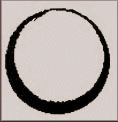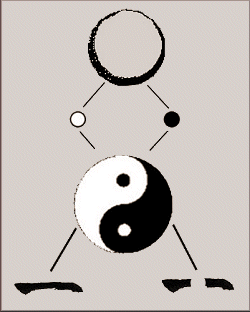The central premise of the Yijing, “all things change” is derived from the principles of Yin and Yang. These two ideas Yin and Yang are not spoken of as separate but as one dualistic concept. Collectively the Yin and Yang are known as the Taiji (Great supporting principle). Taiji can produce a formula that ancient Chinese sages discovered could explain the way natural law unfolds in the universe. We can begin to study the eight trigrams by observing how simply they are derived from the Taiji.
Concepts of The Yijing
Wuji

To know the Taiji we must understand the theory from whence it sprang. Chinese cosmology teaches a very similar lesson to the modern physics theory of the origins of our universe. This theory is called the Big Bang. Simply put it states that all things came from a single event, a great explosion that took place billions of years ago. Before this event there was no time, space or matter simply a “point of unknown” In China this point of ultimate nothing that contains the potential for the creation of all things is called Wuji (nothing principle) or the void.
Wuji is the ultimate point of origin for all that is. Wuji is represented in calligraphy by a simple circle drawn with one stroke of a brush. The shape symbolizes all things contained yet not known or understood before creation began. This is Wuji.
The Void is beyond time and space. It is not physical or non-physical; yet, it is the eternal now. It is everywhere, both within and without our universe. It permeates and encompasses every form of existence. It is at the core of all being, yet it is neither being nor non-being.
Wuji is the perfect creative principle. The perfection of Wuji is unlimited, and because of this, it can be neither good nor bad, male nor female. It is formless form, perfect within itself, self-creating, eternal and self-sufficient. It is the Alpha and Omega of all the known and unknown universe, the creator of all that is. It never acts for or against its myriad creations. Neither reward nor punishment comes forth from Wuji, for if it were to take action – either positively or negatively – it would reduce its purity and no longer be the Void.
Taiji
Wuji in the Chinese cosmology of the Yijing is the originator of the two energies of Yin and Yang. Just as in the big bang when matter and anti-matter exploded into being and the world began so Wuji is said to have given birth to the energies of Yin and Yang. This creation of Yin and Yang is an analogy for the  beginning of energy or Qi in the universe. It is through the interaction of vibrations from positive and negative energies that all matter in the universe is formed. Just so the Yin and the Yang are merely the Chinese names for these myriad interactions.
beginning of energy or Qi in the universe. It is through the interaction of vibrations from positive and negative energies that all matter in the universe is formed. Just so the Yin and the Yang are merely the Chinese names for these myriad interactions.
Long after Fu Xi formed the concept of the Yijing and the eight Gua another Chinese scholar designed a symbol to represent the interaction of the polar energies. This new symbol was called the Taiji Du. The white and black circle of the Taiji Du also known by some as the Yin and Yang symbol is often seen in drawings and books of the Yijing.
Wuji is the unchanging field upon which the concept of (Yi) change can occur. If there is no change, then nothing happens this is the void, stillness. If there is change or even the possibility of change, we can say then that Wuji has given birth to the Taiji. The interaction of Yang and Yin is beginning. In the Yijing the concept is represented as we see here. The Wuji creates the inseparable energies of Yin and Yang known as the Taiji Du. Taiji can be translated as the “ridgepole” or central principal. It refers to the founding energies of the universe distilled to their essence, the Yin and Yang.